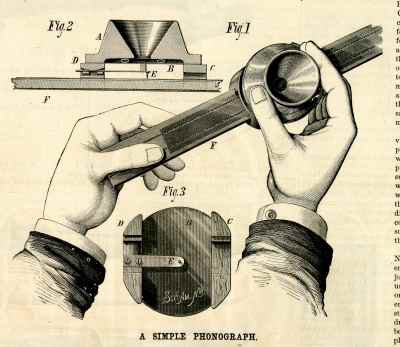
Phonozoic Text Archive, Document 119
A Simple Phonograph
Scientific American XXIX:8 (August 24, 1878), p. 118.

This simple instrument, which is shown in perspective in Fig. 1, in section in Fig. 2, and in plan in Fig. 3, consists of a mouthpiece, A, to which is attached a thin ferrotype plate diaphragm, B, by means of a good quality of sealing wax or cement.
Upon the outer face of the diaphragm and at opposite edges there are guides, C D, for receiving the wooden strip, F. These guides present only a slight bearing surface to the strip. The guide, D, is rounded to receive the spring, E, which is secured to it by two screws, by which also the spring is adjusted so as to bear with more or less force on the small rubber block which rests upon the center of the diaphragm.
A needle, which is sharpened like a leather sewing needle or awl, is soldered to the spring, and is located directly opposite the center of the diaphragm. The guides, C D, are placed so that the median line of the strip, F, is at one side of the needle. The strip, F, has four slight longitudinal grooves, two on each side, which are made with an ordinary carpenter’s gauge. These grooves are located so that when the strip is moved through the guides, one or the other of them will pass over the needle. A piece of beeswax is rubbed over the sides of the strip to give it an adhesive coating for receiving the foil used in recording the sounds.
The foil, which should be
rather heavy, must be cut into strips wide enough to extend beyond the grooves
in the wooden strip. The foil is laid on the wooden strip and burnished down
with the thumb nail, so that it will adhere. The strip thus prepared is placed
in the guides, C D, and the needle is adjusted so that it indents the foil
slightly as the stick is moved along.